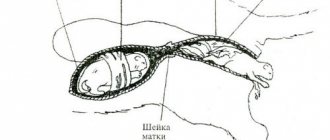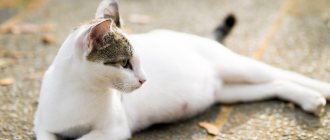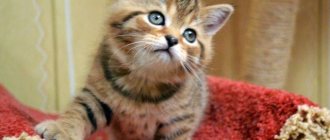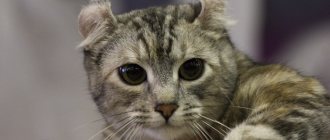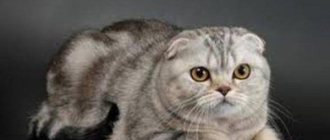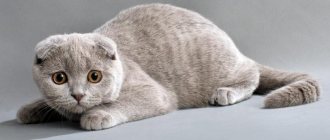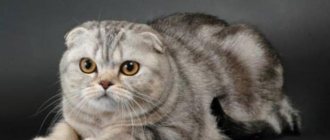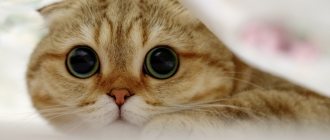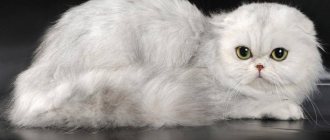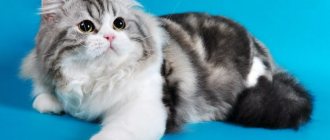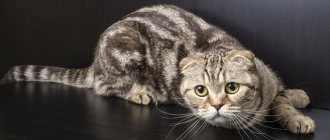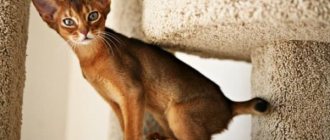Below you will read about how to give birth to a Scottish Fold and Straight-eared cat, provided that there are no serious complications and professional help is not required.
In cats, there are three stages of labor: the first ends with the dilation of the cervix and contractions, the cat is in pain - she may moan or meow pitifully; the second period is the actual birth of kittens; the third is the release of the placenta. The duration of labor in a Scottish cat depends on a number of factors, but usually it lasts about a day.
First stage of labor
The first period begins with pushing - contractions of the uterus. As a result, the cat's breathing quickens, the pet becomes restless, it hurts, and watery discharge may come out of the vagina.
The duration of the first stage of labor in a cat can range from 12 to 24 hours. At this time, she does not necessarily lie in the nest, but may walk around the apartment in agony. Attempts are also determined by other signs: the cat digs the floor with its paws, turns its head back as if trying to bite its butt, and pushes.
The purpose of this stage of labor is to push the fetuses from the uterus to its cervix, as a result of which the birth canal opens.
Second stage of labor
The beginning of the birth of kittens (the second period) is considered to be the release of gray-red “water” from the vagina and the complete opening of the birth canal. The cat meows, grunts, strains, and can lie in the nest without getting up.
After the water breaks, with normal opening of the birth canal and sufficient contractions, kittens will begin to emerge from the cat. They will be in water bladders, or so-called amnions (one bladder for each kitten). You need to make sure that the cat does not bite through the bubble until the kitten is born: without it, the kitten may die.
Usually kittens are born head first, but in 30% of cases they walk forward with their hind legs. Often in such a situation, the cat pinches the vaginal muscles - and they interfere with the release of the fetus. If you see that this is exactly what is happening, you can try to help the cat relax: gently grab it by the scruff of the neck and put it on its paws (you can’t hold it in the air, as you can damage the spine). As a result of such manipulations, the cat will switch to pain in the withers and unclench the vaginal muscles. If this does not help, take a napkin, gently grab the kitten by the skin and pull it out with rocking movements in time with the cat's contractions. It is very important to pull precisely at the moments of pushing, and not between them. And under no circumstances should you grab a kitten by its paws or tail. If you click on the photo, additional illustrations will open in a separate window.
After the kitten comes out, the cat breaks the water bladder, if it has not already burst, and gnaws the umbilical cord, and then licks the kitten, clearing its mouth and nose. All this allows the baby to take his first breath. Without these manipulations, the kitten will suffocate. If the cat has not started doing them herself, the responsibility will fall on you. Within 30 seconds after the kitten is born, you need to break the bubble with scissors, and then free the kitten’s nose and mouth from mucus using a napkin and a microenema. If you do not have time, the newborn may choke. The result of cleaning the respiratory tract should be a kitten squeak without impurities or gurgling, that is, a clear sound.
To completely clean not only the nose and mouth, but also the lungs, after sucking out the mucus with an enema, you can put the kitten on your palm and, covering it with a second palm, turn it head down, then shake your hands from top to bottom, but so that the kitten itself is not inside your palms. he was afraid, but lay tightly. That is, the kitten should only move relative to the floor, but not relative to your palms.
Only after the kitten's first breaths can the umbilical cord be cut. The fact is that after the umbilical cord ruptures, the kitten will inhale in any case, but if the airways have not yet been cleared, it will choke. The umbilical cord must be cut with sterile scissors or rubbed with your fingers at a distance of 2-3 cm from the abdomen. After 3 days it dries completely and falls off.
If for some reason the cat does not lick the kitten herself (for example, she is giving birth to the next one), take a damp piece of gauze and massage the body to stimulate blood circulation, as well as the anus, so that the newborn pee and poop. After the kitten, you need to blot it with a towel and place it next to the mother; if she is currently in labor, if she is giving birth, then on a warm heating pad. As soon as you see that the cat is having another contraction, take the kitten and place it on a heating pad in a separate place nearby.
Third stage of labor
Kittens are born on average every 15-30 minutes. As a result, everything is born within 2-6 hours. Sometimes there are breaks in childbirth when the cat, expecting new kittens, takes care of those that have already been born. Labor may stop for 12-24 hours, then labor may resume. But you shouldn’t worry only if the cat behaves calmly and you don’t think that everything is okay with it. If she clearly doesn't feel well, call your veterinarian.
After each kitten is born, its placenta comes out within a few minutes. As many kittens are born, there should be as many afterbirths. If there are fewer afterbirths than kittens, this means that they are stuck inside. If you click on the photo, additional illustrations will open in a separate window.
A cat can eat the placenta: don’t be surprised - it’s healthy and is done to improve lactation. But make sure that the cat eats no more than 2 afterbirths, otherwise she may diarrhea.
And make sure that the cat, while eating the placenta, does not accidentally eat the kitten. Although sometimes she deliberately eats a sick kitten, since nature does not need weak ones.
After all the kittens have been born, you can inject the cat with 0.3 ml of oxytocin subcutaneously or intramuscularly. This strengthens the contractions of the uterus so that it is better cleansed, and gives a rush of milk.
Also watch abnormal births in Scottish cats on video.
At what age can you knit tartan?
The first heat in Scottish cats, like in other cats, should be expected at 8 months. However, the body has not yet finished growing, and early pregnancy can undermine the health of the pet. And the offspring of a precocious mother will not be in good health.
Scots are considered large pets, so they are ready for the first mating later than cats of smaller breeds. The optimal age for the first pregnancy is one and a half years.
A partner for the Scottish female should be looked for several months before the intended mating, preferably not far from home, in order to have time to connect the couple on the 2nd or 3rd day of estrus.
How does the number of babies affect the health of the mother?
Stimulation of multiple pregnancy can lead to the development of unfavorable processes in the body of the cat and its offspring:
- The birth of weak, non-viable offspring. During pregnancy, a large number of embryos cannot always receive a sufficient amount of nutrition, and with it a minimum of useful microelements. The anatomical features of the female may be unsuitable for bearing such an offspring; accordingly, the cubs will not have enough space in the womb, which affects their size.
- Increased risk of complications during childbirth and the postpartum period, which can lead to forced surgery to remove the uterus and ovaries.
- There is a likelihood of a shortage of mother's milk in sufficient quantities for each baby, which will require owners to purchase artificial nutrition. You will also have to take the time to syringe feed the kittens.
A small pregnancy is no less fraught with consequences. For example, one kitten in the womb will receive everything it needs from its mother for several, eventually growing to a large size and getting stuck in the birth canal. And the production of a large amount of milk, which 1-2 cubs simply cannot eat on time, can lead to the development of mastitis.
Signs of pregnancy in Scottish cats
After mating, the cat calms down and becomes imposing. If the pet does not have contact with other animals at this time and eats according to its needs, the onset of pregnancy proceeds without problems. The first signs of pregnancy are observed 2-3 weeks after conception. The cat, as well as the woman, experiences attacks of morning sickness, characteristic of toxicosis of pregnancy.
The pet's nipples begin to turn pink, and the hair around them gradually falls out. However, such changes are individual and ultrasound is a reliable test for pregnancy. The first examination is usually carried out 3 weeks after mating.
Be sure to read:
Pregnant Sphynx cat: how to find out about the position, changes in behavior and appearance, how long they walk
Even an inexperienced owner can determine that the cat is pregnant in the sixth week of gestation.
By this time, her belly is rounded, her nipples swell, and her mammary glands enlarge.
Behavior of a pregnant fold cat
A pregnant cat changes its behavior. Hormonal surges change behavior. The cat alternately pets and looks irritated. Fetal development increases food requirements during the fourth week of pregnancy. At that time, the feed portion can be increased by 10-15%. In subsequent weeks, the animal is no longer restricted in food, but in order to avoid overeating, it is fed in small portions, but often.
The best option is to switch to ad libitum feeding with dry granules. The fifth week of pregnancy has only just begun, and the Scotswoman is already beginning to nest: she is looking for a secluded place. If the owners are planning to purchase a cat house, then this time is most suitable for the implementation of the intention.
During the seventh week, the cat may lose its appetite for a while. The embryos begin to grow fur and the cat hibernates at this time. The body is rebuilt, some of the nutrients are redirected into the formation of fruits to prepare the mammary glands for lactation. This process requires calmness, so the cat becomes drowsy.
In the last weeks before lambing, the Scotch cow becomes active again, once again walking around the property in search of a more convenient nest. It's time to satisfy your curiosity and repeat the ultrasound. You can determine the number of fruits and observe their movements. However, someone may be undetected and the actual number of kittens turns out to be greater than expected.
Nutrition
In the first weeks of pregnancy, the Scottish cat eats as usual. But in the later stages, the pet gradually refuses frequent meals because... kittens grow and take up all the space in the stomach. In this case, you should reduce the diet, but give portions more often 4-5 times a day.
For a pregnant cat, not just a proper diet is important, but also one rich in minerals and vitamins . It would be a good idea to add special vitamin complexes to the bowl, which can be purchased at the pharmacy.
If your cat's diet consists of dry food, it is recommended to gradually add canned food for kittens to the bowl. By the end of pregnancy, the menu should preferably consist of canned food. When eating natural foods, experts recommend including the following foods in your diet:
- boiled meat (about half of the diet);
- boiled vegetables;
- eggs;
- small portions of lean boiled fish (in no case sea fish!)
To improve the functioning of the digestive system, it is recommended to add beet puree to the diet.
To actively produce milk, you can feed your cat a salad of scalded nettle leaves. To facilitate childbirth and prevention, you can give a decoction of raspberry leaves. Twice a day - morning and evening.
What to feed a pregnant Scottish Fold cat
No special food has been developed for pregnant and lactating cats. Manufacturers of ready-made food believe that the nutritional needs of a mother cat are the same as those of kittens. Therefore, it is recommended to switch a pregnant pet to baby food from the moment pregnancy is considered established.
Be sure to read:
A pregnant cat has bleeding: normal or pathological, what to do when you need help
That is, if on the 25th day after mating an ultrasound showed the presence of embryos, the cat begins to gradually replace the previous food with a new one. This should be done gradually over a week to prevent feeding stress, which will negatively affect the fruit.
If an ultrasound was not performed for some reason, the transition to a new food begins when pregnancy is established based on other signs.
Malyshovsky food is as close as possible to milk in terms of energy and protein concentration, therefore it contains a lot of fat. For this reason, it should not be given immediately after mating, since Scottish females are prone to obesity.
The best option is universal holistic food such as Acana or Orijen, or specialized food Royal Canin Mother & Babycat. Adherents of natural food should create a diet that is not inferior in nutritional value to the indicated ready-made food.
Pet care
During pregnancy, a cat needs good nutrition, care, and attention. The diet must be balanced, taking into account the condition of the pet. You need to add vitamins or switch to special food.
A balanced diet is important
Attention! It is important to increase the number of meals rather than the portions, since fruits take up a lot of space and put pressure on the stomach. The cat can no longer eat much at one time.
Do not forget to periodically show your cat to the veterinarian, even if she feels well. This way you can eliminate potential troubles in a timely manner or simply make sure that everything is in order.
Closer to childbirth, you need to prepare the necessary tools in case you need help. You also need to help the animal find a secluded place. Just put a box for her or arrange a bed in a semi-dark place, put a soft bedding.
How to help a Scottish woman during childbirth
The first aid before lambing is preparing the den. The simplest option is a cardboard box with holes cut for ventilation, lined with paper and covered with a soft cloth. The future house for kittens is placed in a secluded place. The nesting cat is picked up and placed in a prepared place. If the cat shows willfulness and lambs in another place. She, along with her offspring, is placed in a prepared den, from which she will never leave.
Be sure to read:
After giving birth, the cat has bleeding on the 2-3rd day, is restless, meows and breathes quickly
It is good if a veterinarian is present during the birth, but most owners can provide assistance on their own. Most often, the cat copes on its own.
Labor begins with the release of amniotic fluid. The kitten is born in the amniotic sac, which bursts and the cat gnaws the umbilical cord. If she did not do this, you need to cut the cord with sterile scissors and treat the stump with tincture of iodine. The mother usually eats the placenta. This is normal, but you should not allow more than two placentas to be eaten. When the cat has the intention of eating another afterbirth, food is added to it.
If the bubble does not open on its own, it is broken with your fingers. The kitten is shaken, the liquid is removed from the mouth with a baby syringe and placed on the mother.
The normal interval between the births of kittens is considered to be a quarter of an hour. All afterbirths come out within half a day after the birth of the last kitten. If labor is difficult, call a veterinarian.
What you need to have on hand to help
A non-specialist is unlikely to be able to accurately determine whether in a given specific situation the help of a specialist is needed or whether independent participation will be sufficient. But if it is definitely decided to control the birth without a veterinarian, then the list of available materials should be as follows:
- surgical gloves (disposable or sterile) – 2-3 pairs;
- moisture-absorbing medical diapers (unscented) – 4-6 pieces, depending on size;
- a small waffle towel (clean, intensively ironed) - may be needed for resuscitation of a weak newborn baby;
- gauze or bandage wipes (sterile) – up to 2 packs;
- good cutting blunt scissors;
- surgical silk, catgut or any other surgical thread for tying the umbilical cord - sterile initially or soaked in alcohol on the eve of the expected birth;
- a small rubber bulb (syringe) – for pumping out mucus from the kitten’s airways;
- sterile petroleum jelly;
- hydrogen peroxide 3%, betadine or brilliant green solution;
- ammonia;
- a heating pad or electric sheet if the room is cool.
We recommend reading: Modern antibiotic therapy in industrial poultry farming.
Only after consultation with a veterinarian (!) the following are added to the list:
- oxytocin;
- lauritin;
- calcium gluconate;
- disposable syringes - insulin and regular, 2 ml volume.
In general, consultation with a veterinarian is required! If a decision has been made to perform obstetric care on your own, then there must be a clear understanding of what is needed, why, and when the use of this or that material/drug will be appropriate.
